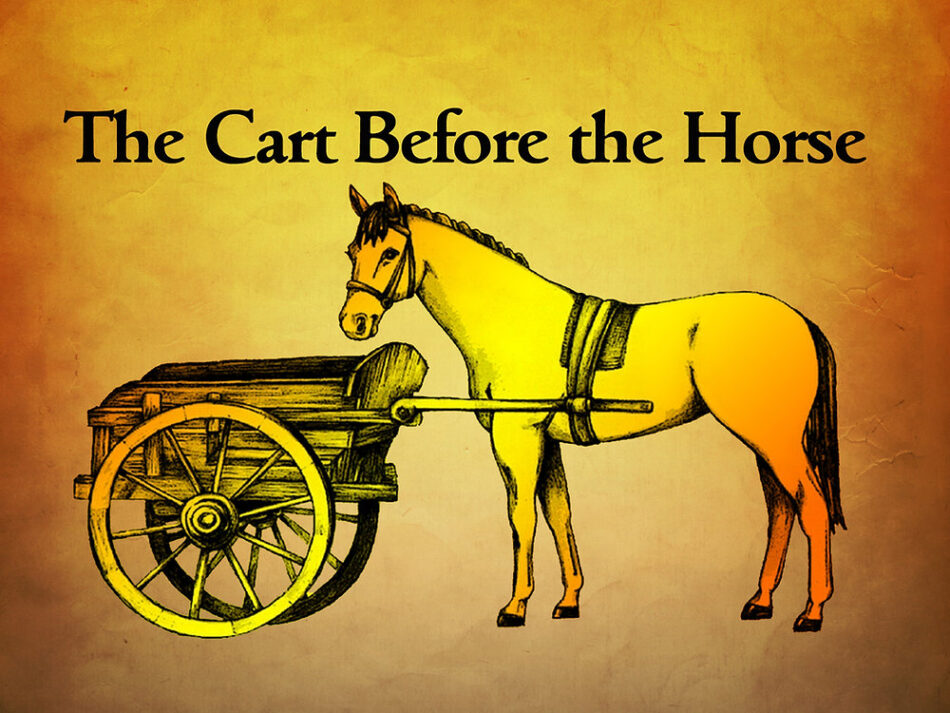
Page Description
To put the cart before the horse: Doing things in the wrong order or manner. Understand this idiom and its true meaning.
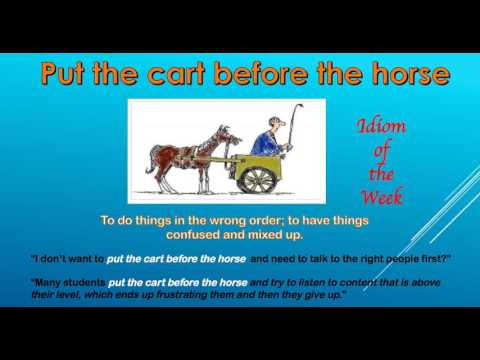
De kar voor het paard spannen
to do things in the wrong order or sequence
to do something in wrong manner
reverse the right method of doing something
Source: www.theidioms.com
Example Sentences
- Aren’t you putting the cart before the horse in decorating your new office? You haven’t even been awarded the job yet.
- Don’t put the cart before the horse by investing in a new shop before selling that old one situated in west of the city.
- By waking up late at night and sleeping all day long. Why are you putting the cart before the horse?
- I think you are putting the cart before the horse by leaving your permanent job before getting new one.
A conviction and no-crime is putting the cart before the horse
In other words, shoot first and then draw the rose.
M.a.w. eerst schieten en dan de roos tekenen.
The phrase “to put the cart before the horse” is an idiomatic expression that means to reverse the proper order of things, or to do something in a way that is illogical or counterproductive. The key points of this phrase are:
Incorrect order: The phrase suggests that the cart, which is usually pulled by a horse, is being placed in front of the horse instead of behind it. This indicates a reversal of the usual or logical order of things.
Lack of logic: The phrase conveys a sense of illogical or irrational behavior, where something that should come after is being placed before, leading to confusion or inefficiency.
Counterproductivity: Placing the cart before the horse is likely to result in an inability to move forward effectively, as the horse cannot pull the cart when it is in front of it. This emphasizes the importance of following a proper sequence or order in achieving desired outcomes.
Metaphorical use: While the phrase has literal origins related to the arrangement of a cart and a horse, it is often used metaphorically to describe situations where steps or actions are taken in the wrong order or sequence, leading to difficulties or failures.
In summary, “to put the cart before the horse” signifies a reversal of order, illogical behavior, counterproductivity, and is often used metaphorically to describe situations where things are done out of sequence or in an illogical manner.

1 No-Crime Wrongful Convictions | Jessica Henry | TEDxButler
8 dec. 2021
3 Wrongful Convictions: Last Week Tonight with John Oliver (HBO)
7 mrt. 2022
2 Dwaling: hoe raken we van ons pad af? – Nico Kwakman
8 jul. 2011
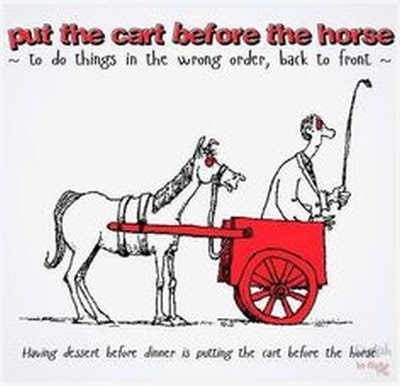
Having dessert before diner is putting the cart before the horse.
4 Lawyers Tour met Peter van Koppen
5 okt. 2016
5 Ton Derksen: ‘1000 Nederlanders onschuldig achter de tralies’
Educational: This video is essential viewing
Educational: This video is essential viewing
Een gerechtelijke dwaling in Nederland
6 Ton Derksen bekritiseert undercoveroperatie politie in moordzaak Heidy Goedhart.
15 jul. 2015
7 Peter van Koppen: “Onderzoek die zaak een keer echt goed” – RTL LATE NIGHT
5 apr. 2017
8 Wrongfully Convicted: LaDondrell Montgomery Story
7 mei 2012
9 Prof Peter van Koppen.mpg

“If you make a mistake and do not correct it,
this is called a mistake.“
10 Verhalenverteller Geert Jan Knoops
1 okt. 2012
11 Verbijsterend veel ging mis – RTL LATE NIGHT
Curbing miscarriages of justice
In criminal cases, guilt or innocence is sometimes difficult to establish. The evidence is often contradictory, and little or no account is taken of the possibility that the defendant is innocent, especially if he or she has confessed to committing the crime. According to the law, the judge may convict if he is convinced of the guilt of the suspect on the basis of legal evidence. That is a very meager indication.
On guilt and innocence in criminal cases
In this book, legal psychologist Peter van Koppen explains how the decision about the guilt of the suspect can be made in a responsible manner. Illustrated with many examples from recent Dutch criminal cases, he makes clear which evidence is strong and which is weak. He also explains how guilty and innocent scenarios can be formulated and weighed against each other. Decisions in criminal cases can thus be elevated to a scientific level. This makes Overtuigend bewijs an indispensable book for anyone with an interest in cases of legal and social importance.
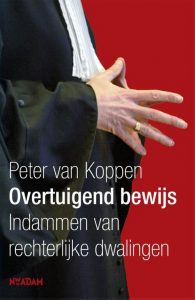
Indammen van rechterlijke dwalingen
In strafzaken is schuld of onschuld soms moeilijk vast te stellen. Het bewijs is vaak tegenstrijdig, en er wordt weinig of geen rekening gehouden met de mogelijkheid dat de verdachte onschuldig is, zéker wanneer deze heeft bekend het delict te hebben gepleegd. Volgens de wet mag de rechter veroordelen als hij op grond van wettige bewijsmiddelen overtuigd is geraakt van de schuld van de verdachte. Dat is een wel erg magere aanwijzing.
Over schuld en onschuld in strafzaken
In dit boek legt rechtspsycholoog Peter van Koppen uit hoe de beslissing over de schuld van de verdachte wél verantwoord kan worden genomen. Gelardeerd met vele voorbeelden uit recente Nederlandse strafzaken maakt hij duidelijk welk bewijs stevig en welk zwak is. Ook zet hij uiteen hoe schuldige en onschuldige scenario’s geformuleerd kunnen worden en tegen elkaar afgewogen. Beslissingen in strafzaken kunnen zo naar een wetenschappelijk niveau worden getild. Daarmee is Overtuigend bewijs een onmisbaar boek voor eenieder met belangstelling voor zaken van juridisch en maatschappelijk belang.
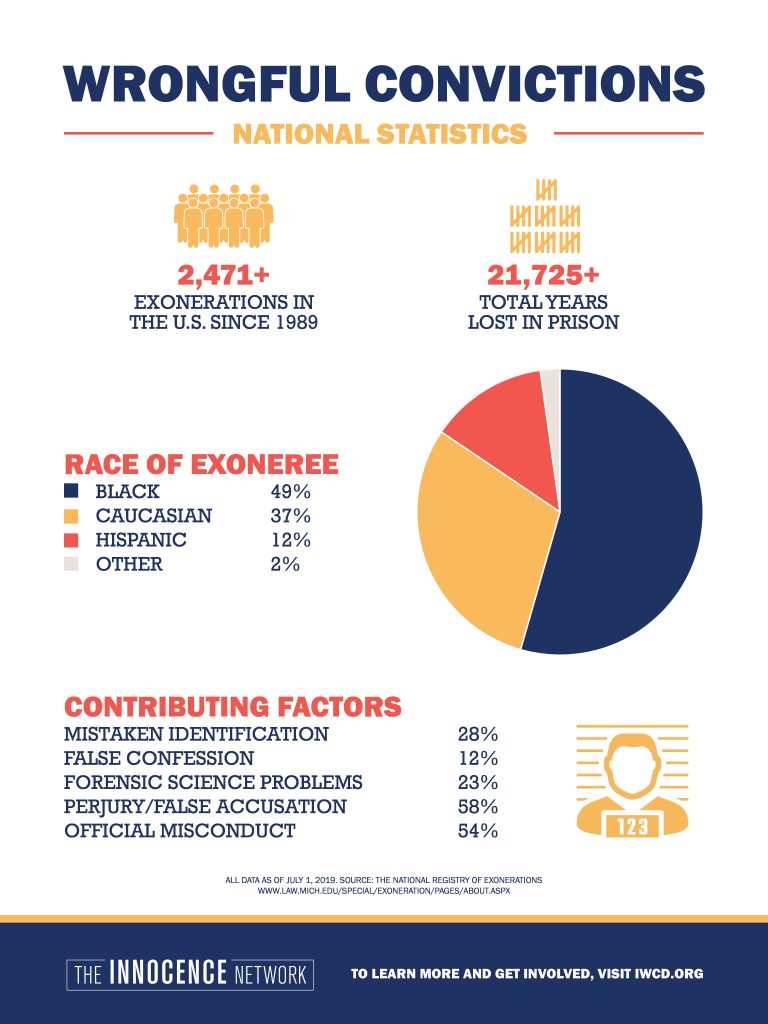
12 Kareem zat 14 jaar onterecht in de gevangenis
24 jan. 2015
The key points of Kareem’s wrongful imprisonment for 14 years are:
- Kareem was wrongfully convicted and imprisoned for a crime he did not commit.
- He spent 14 years in prison before being exonerated and released.
- The wrongful conviction was based on false evidence and testimony.
- Kareem’s case was reviewed and overturned due to the efforts of a legal advocacy organization or a team of lawyers.
- Kareem suffered significant harm and trauma as a result of his wrongful imprisonment, including the loss of freedom, separation from his family, and emotional distress.
- The case highlights the issue of wrongful convictions and the importance of ensuring that the criminal justice system is fair and just.
- Efforts must be made to prevent wrongful convictions from occurring and to provide support and compensation to those who have been wrongfully convicted and imprisoned.
Australia’s Greatest Gold Swindle: The Corrupt Tale of Tony Lewandowski
Three brothers went to jail for that crime, and it was Lewandowski’s evidence that sent them there.
But that evidence was false – the Mickelbergs were framed.
Read the text: read more
13 Crooked cop’s confession about Australia’s biggest gold swindle | 60 Minutes Australia
14 dec. 2021
Full Episodes: https://9now.app.link/uNP4qBkmN6 | Dead Man Talking (2004)
Three brothers went to jail for that crime, and it was Lewandowski’s evidence that sent them there. But that evidence was false – the Mickelbergs were framed.
14 THE GREAT MINT SWINDLE: Trailer
15 THE GREAT MINT SWINDLE: Conspiracy Map
The key points of one of the biggest gold swindles in Australia’s history, which involved a corrupt cop named Tony Lewandowski, are:
- The swindle took place at the Perth Mint in Western Australia in 1982.
- The heist involved stealing 68 kg of gold bullion, worth millions of dollars.
- The investigation into the heist led to the arrest and conviction of three brothers, the Mickelbergs, based on evidence provided by Lewandowski.
- The Mickelbergs were later found to have been wrongfully convicted due to the false evidence presented by Lewandowski.
- Lewandowski was a corrupt cop who was involved in the swindle and helped to cover up the true identity of the perpetrators.
- Lewandowski’s involvement in the swindle was uncovered through a recorded interview or confession he gave shortly before his suicide.
- The case has been the subject of significant media attention and public interest due to its high-profile nature and the implications of the wrongful conviction of the Mickelbergs.
16 Reizen met mijn rechter
30 mrt. 2010
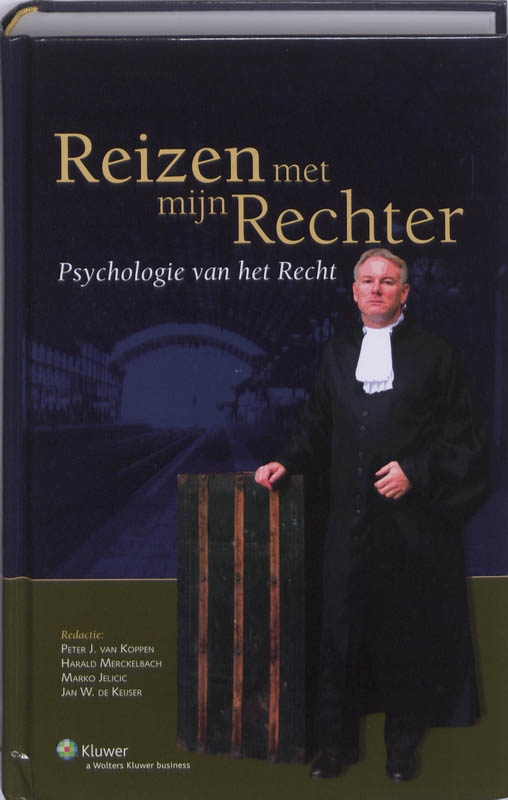
€ 82.50, Hardback, 1300 pages, With illustrations, March 2010, 1803 grams, 250 x 168 x 47 mm
The law and the legal system attempt to direct people’s behavior. This is done by interviewing eyewitnesses, taking reports from victims, remanding suspects in custody, weighing evidence, and punishing offenders; to name a few topics. These are topics about which legal psychology has much to say. Traveling with my Judge sets forth in 57 chapters the current state of knowledge in the field of legal psychology.
How reliable are witnesses? How do police officers conduct their investigative investigations? Why does someone who has been raped feel guilty? Can we tell by looking at someone if they are lying? How do false confessions occur? How should children and the mentally disabled be questioned? Why does punishment sometimes help and sometimes not? What is the value of evidence? What mistakes can judges make? How do miscarriages of justice occur? Does the lie detector work? What is proper recognition? Can you repress traumatic memories?
Without unnecessary legal and psychological jargon, Traveling with my Judge answers these and other questions in the areas of both criminal and civil law. This makes this book a pleasant reference work and excellent course material.
Het recht en het juridisch systeem proberen het gedrag van mensen te sturen. Dat wordt gedaan door ooggetuigen te ondervragen, van slachtoffers aangiften op te nemen, verdachten in voorlopige hechtenis te nemen, bewijsmiddelen te wegen en daders te straffen; om maar eens een paar onderwerpen te noemen. Het zijn onderwerpen waarover de rechtpsychologie veel te zeggen heeft. Reizen met mijn Rechter zet in 57 hoofdstukken de huidige stand van de kennis op het gebied van de rechtspsychologie uiteen.
Hoe betrouwbaar zijn getuigen? Hoe voeren politieambtenaren hun opsporingsonderzoeken uit? Waarom voelt iemand die verkracht is zich schuldig? Kunnen wij aan iemand zien of hij liegt? Hoe ontstaan valse bekentenissen? Hoe moeten kinderen en verstandelijk gehandicapten worden verhoord? Waarom helpt straffen soms wel en soms niet? Wat is de waarde van bewijs? Welke fouten kunnen rechters maken? Hoe ontstaan rechterlijke dwalingen? Werkt de leugendetector? Wat is een goede herkenning? Kun je traumatische herinneringen verdringen?
Zonder onnodig juridisch en psychologisch jargon geeft Reizen met mijn Rechter op deze en andere vragen op het terrein van zowel het strafrecht als het civiele recht een antwoord. Daarmee vormt dit boek een prettig naslagwerk en uitstekend cursusmateriaal.
Extra informatie:
€ 82.50
Hardback
1300 pagina’s
Met illustraties
Maart 2010
1803 gram
250 x 168 x 47 mm
EAN: 9789013069129
Wolters Kluwer Nederland B.V.
Study: At Least 2,000 People Wrongfully Convicted In 23 Years
Innocent people have gone to jail, and some of them are still sitting there.
DOUG MATACONIS · MONDAY, MAY 21, 2012 ·

A new study has unveiled at least 2,000 incidents over the past 23 years in which people were convicted of a crime that they didn’t commit:
More than 2,000 people who were falsely convicted of serious crimes have been exonerated in the United States in the past 23 years, according to a new archive compiled at two universities.
There is no official record-keeping system for exonerations of convicted criminals in the country, so academics set one up. The new national registry, or database, painstakingly assembled by the University of Michigan Law School and the Center on Wrongful Convictions at Northwestern University School of Law, is the most complete list of exonerations ever compiled.
The database compiled and analyzed by the researchers contains information on 873 exonerations for which they have the most detailed evidence. The researchers are aware of nearly 1,200 other exonerations, for which they have less data.
They found that those 873 exonerated defendants spent a combined total of more than 10,000 years in prison, an average of more than 11 years each. Nine out of 10 of them are men and half are African-American.
Nearly half of the 873 exonerations were homicide cases, including 101 death sentences. Over one-third of the cases were sexual assaults.
DNA evidence led to exoneration in nearly one-third of the 416 homicides and in nearly two-thirds of the 305 sexual assaults.
At first glance, you might say that 2,000 wrongful convictions over 23 years, but that only lasts as long as it takes you to realize that the data that the two universities based their study on was limited, and that some jurisdictions reported numbers that quite simply aren’t believable:
The overall registry/list begins at the start of 1989. It gives an unprecedented view of the scope of the problem of wrongful convictions in the United States and the figure of more than 2,000 exonerations “is a good start,” said Rob Warden, executive director of the Center on Wrongful Convictions.
“We know there are many more that we haven’t found,” added University of Michigan law professor Samuel Gross, the editor of the newly opened National Registry of Exonerations.
Counties such as San Bernardino in California and Bexar County in Texas are heavily populated, yet seemingly have no exonerations, a circumstance that the academics say cannot possibly be correct.
The registry excludes at least 1,170 additional defendants. Their convictions were thrown out starting in 1995 amid the periodic exposures of 13 major police scandals around the country. In all the cases, police officers fabricated crimes, usually by planting drugs or guns on innocent defendants.
Regarding the 1,170 additional defendants who were left out of the registry, “we have only sketchy information about most of these cases,” the report said. “Some of these group exonerations are well known; most are comparatively obscure. We began to notice them by accident, as a byproduct of searches for individual cases.”
Perhaps the most significant piece of information about this database, as limited as it may be, is that it makes quite c ear that wrongful convictions and the factors that lead to them aren’t limited to high-profile cases. When exoneration cases do get publicity, it’s usually in situations involving rape and murder, of course. Here at OTB, we’ve made note of three death penalty cases from the State of Texas alone — Cameron Todd Willingham, Claude Jones, and Carlos DeLuna — where men were executed for crimes they didn’t commit. In the State of Mississippi, Cory Maye spent ten years on death row for a capital murder conviction tainted by racism, improper testimony from a corrupt Medical Examiner, and a case of mistaken identity by police conducting a no-knock drug raid. Beyond those cases, we’ve all seen more than one story about a man, and it’s usually always a man and an African American man at that, who has spent decades in prison for a crime they didn’t commit. What this study makes clear, though, is that it isn’t just rape and murder that leads to improper convictions, and that the factors that bring it about are rather unsurprising:
In half of the 873 exonerations studied in detail, the most common factor leading to false convictions was perjured testimony or false accusations. Forty-three percent of the cases involved mistaken eyewitness identification, and 24 percent of the cases involved false or misleading forensic evidence.
In two out of three homicides, perjury or false accusation was the most common factor leading to false conviction. In four out of five sexual assaults, mistaken eyewitness identification was the leading cause of false conviction.
Seven percent of the exonerations were drug, white-collar and other nonviolent crimes, 5 percent were robberies and 5 percent were other types of violent crimes.
The problem of faulty eyewitness identification is one that has been well-known in the criminal justice field for years, even though most lay observers seem to think that, out side of DNA, it is one of the most reliable types of evidence presented at trial. The reality, as I noted, is far different, as the Supreme Court of New Jersey acknowledged when it completely revamped the Court rules for eyewitness testimony after an exhaustive study that showed just how unreliable it can be:
“Study after study revealed a troubling lack of reliability in eyewitness identifications,” Chief Justice Rabner wrote. “From social science research to the review of actual police lineups, from laboratory experiments to DNA exonerations, the record proves that the possibility of mistaken identification is real.
“Indeed, it is now widely known that eyewitness misidentification is the leading cause of wrongful convictions across the country.”
The decision listed more than a dozen factors that judges should consider in evaluating the reliability of a witness’s identification, including whether a weapon was visible during a crime of short duration, the amount of time the witness had to observe the event, how close the witness was to the suspect, whether the witness was under the influence of alcohol or drugs, whether the witness was identifying someone of a different race and the length of time that had elapsed between the crime and the identification.
Chief Justice Rabner said the court had avoided “bright-line rules that would lead to suppression of reliable evidence any time a law enforcement officer makes a mistake.”
The ruling instead allowed for a much more complete exploration of the factors involved in an identification “to preclude sufficiently unreliable identifications from being presented and to aid juries in weighing identification evidence.”
Chief Justice Rabner noted that in the vast majority of cases, identification evidence would still be presented to a jury.
“The threshold for suppression remains high,” he wrote. And because, in most cases, juries will continue to determine the reliability of eyewitness testimony, Chief Justice Rabner added, “it is essential to educate jurors about factors that can lead to misidentifications.”
Indeed, given the fact that this study found that nearly half of the wrongful convictions this study dealt with involved mistaken eyewitness identification, one would think that this reform that is long overdue throughout the country.
It would be interesting to see this study expanded to see just how big a problem wrongful convictions actually is, and perhaps to add into it some study of people who ended up confessing to crimes they didn’t commit. Given the fact that some jurisdictions don’t even keep data on this matter, though, that won’t be an easy task. Suffice it to say, though, that it seems rather self-evident that the number of wrongful convictions over the past two decades has been far more than 2,000. What this study does make clear, though, as limited as it is, is that we need to seriously look at the way we trial crimes in this country and ask ourselves whether its worth ruining the lives of so many people just to make it more “efficient.”
EVIDENCE
Judge Blasts ‘Spectacularly Incompetent’ Lawyers After Man With Iron-Clad Alibi Is Convicted
BY MARTHA NEIL
DECEMBER 9, 2011, 7:32 PM CST
Convicted and sentenced to life last month, LaDondrell Montgomery had insisted all along that he wasn’t the man identified by eyewitnesses to an armed robbery.
But a Texas jury didn’t believe him and found the 36-year-old guilty in the Harris County case. Yesterday, his conviction was reversed and State District Judge Mark Kent Ellis personally apologized to Montgomery, reports the Houston Chronicle.
A few days after he was sentenced, Montgomery’s attorney, Ronald Ray, who is also representing him in other pending robbery cases, took a close look at his client’s rap sheet and realized he was in jail at the time of the 2009 crime in which he had been convicted. Ray had asked Montgomery before trial where he was during the armed robbery, but he just didn’t remember, the newspaper explains.
“It boggles the mind that neither side knew about this during trial,” the judge said yesterday, blaming both the prosecution and the defense for not realizing earlier that Montgomery literally had an iron-clad alibi. “Both sides in this case were spectacularly incompetent.”
Ray said afterward that he considers the case a success, since he has freed a man who was facing a life sentence.
Prosecutor Alison Baimbridge pointed out that she had investigated Montgomery’s record, once his alibi was brought to her attention, and joined in the defense request for a reversal. As the state’s attorney, she noted, she is generally not permitted to seek such information directly from a suspect prior to trial.
18 Candid Camera Classic: Hydrant on Your Lawn
17 aug. 2015